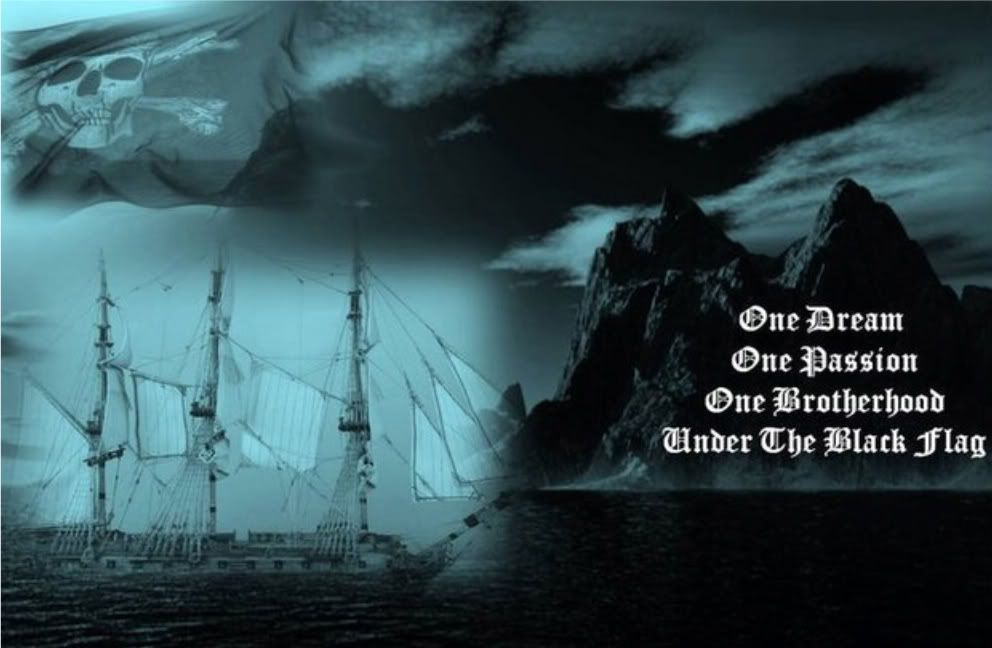Chevalier de Grammont
biographies, Chevalier de Grammont 8:02 π.μ.
[Chevalier is certainly not his first name, but I have yet to run across any definitive reference to it (I have seen it referred to as Michel, Nicolas and Francois). The Chevalier's history must be somewhat embellished as it sounds too much like the typical swashbuckler plot to be 100% true.]
The Chevalier's history begins as the son of a man who had served in the King's Guards. His father is said to have died when he was young and his mother remarried (to another military officer). He was born circa 1643 and as an adult was a small swarthy man. He first embarked upon his life as a pirate/buccaneer as a result of a tragic duel with his sister's suitor, a man he did not approve of. The suitor died as a result of the duel and cast a cloud over the Chevalier's reputation, forcing him to leave France for a while. He served courageously in the West Indies and was eventually given command of a French ship.
His new status as a captain paid off in the capture of a Dutch convoy, valued at about 400,000 livres. His next cruise was not so successful as his ship was driven onto a reef by a storm and wrecked. It is at this time that he decided that privateering was not to his taste and turned to piracy and moved his base of operations from Hispañola proper to the island of Tortuga.
On Tortuga, he used some of the money from the captured Dutch convoy to outfit a new ship. His reputation as a successful captain (from his prior capture of the convoy) assured him of a ready crew. He is next seen joining the ill-fated French fleet under the Comte d'Estrées on his trip to Curacao. The fleet was wrecked on the reef near Las Aves island in 1678. The wreck of the French fleet is claimed by some to have ushered in the Golden Age of Piracy.
Without the might of the French fleet to aid in the capture of Curacao, the buccaneers, in what ships remained (six large and thirteen small), settled on Maracaibo, Venezuela as a likely target. De Grammont sailed with over a thousand men to this Spanish town. Landing his force, in June of 1678, he attacked the town and with the aid of some of the ships' cannon was able to capture the town. Capturing other local towns, including Trujillo, the pirates plundered the whole region, and did not depart until December of 1678, returning to Petite Goâve as heroes.
He is next heard from in June of 1680, joining forces with Thomas Paine and a captain Wright met at Isla La Blanquilla to coordinate their attack on the port of Caracas. The pirates sailed to the port and infiltrated the town with less than 50 men and captured the defending soldiers. The pirates, knowing that they had limited time quickly loaded booty and prisoners onto their ships while de Grammont and Paine with a handful of pirates fought a brave rearguard action against a Spanish force numbering near 2,000 men. Wounded in this action by a sword cut to the neck, de Grammont returned to Las Aves to heal.
Returning from an unsuccessful summer in 1682, in command of eight ships, he sails with Van Hoorn at the request of de Pouancay, governor of Petite Goave to harass the Spanish. They join forces with Laurens de Graff on the island of Roatan to sack Vera Cruz in May of 1683. The pirates herded the city's populace (or as much as possible) into the town's cathedral while they plundered. With little food or water many of the citizens perished. The pirates fled the area after several days of looting to avoid the twelve heavy men of war of the Spanish plate fleet.
The Chevalier is next seen at Isla de Pinos in company with Laurens de Graff, after having spent time in Petite Goave. After failing to finalize plans for an attack on Caracas, the pirates met again of the Mosquito Coast and determined to raid Campeche. The pirates attacked on July 6, 1685 and after several days of fighting finally succeeded in reducing the last resistance. After two months of sacking with little result, de Grammont sent a demand for ransom to the governor, who spurned the demand saying 'he had the funds with which to build or even buy another'.
De Grammont then commenced to execute prisoners as retaliation for the affront. De Graff stepped in and stopped the executions and the pirates departed Campeche.
The last of de Grammont is recorded from April 1686 when he is reported off St.Augustine with a Nicholas Brigaut. He is reported, by a buccaneer named Du Marc, to have been lost with all hands in a storm shortly there after.
The Chevalier's history begins as the son of a man who had served in the King's Guards. His father is said to have died when he was young and his mother remarried (to another military officer). He was born circa 1643 and as an adult was a small swarthy man. He first embarked upon his life as a pirate/buccaneer as a result of a tragic duel with his sister's suitor, a man he did not approve of. The suitor died as a result of the duel and cast a cloud over the Chevalier's reputation, forcing him to leave France for a while. He served courageously in the West Indies and was eventually given command of a French ship.
His new status as a captain paid off in the capture of a Dutch convoy, valued at about 400,000 livres. His next cruise was not so successful as his ship was driven onto a reef by a storm and wrecked. It is at this time that he decided that privateering was not to his taste and turned to piracy and moved his base of operations from Hispañola proper to the island of Tortuga.
On Tortuga, he used some of the money from the captured Dutch convoy to outfit a new ship. His reputation as a successful captain (from his prior capture of the convoy) assured him of a ready crew. He is next seen joining the ill-fated French fleet under the Comte d'Estrées on his trip to Curacao. The fleet was wrecked on the reef near Las Aves island in 1678. The wreck of the French fleet is claimed by some to have ushered in the Golden Age of Piracy.
Without the might of the French fleet to aid in the capture of Curacao, the buccaneers, in what ships remained (six large and thirteen small), settled on Maracaibo, Venezuela as a likely target. De Grammont sailed with over a thousand men to this Spanish town. Landing his force, in June of 1678, he attacked the town and with the aid of some of the ships' cannon was able to capture the town. Capturing other local towns, including Trujillo, the pirates plundered the whole region, and did not depart until December of 1678, returning to Petite Goâve as heroes.
He is next heard from in June of 1680, joining forces with Thomas Paine and a captain Wright met at Isla La Blanquilla to coordinate their attack on the port of Caracas. The pirates sailed to the port and infiltrated the town with less than 50 men and captured the defending soldiers. The pirates, knowing that they had limited time quickly loaded booty and prisoners onto their ships while de Grammont and Paine with a handful of pirates fought a brave rearguard action against a Spanish force numbering near 2,000 men. Wounded in this action by a sword cut to the neck, de Grammont returned to Las Aves to heal.
Returning from an unsuccessful summer in 1682, in command of eight ships, he sails with Van Hoorn at the request of de Pouancay, governor of Petite Goave to harass the Spanish. They join forces with Laurens de Graff on the island of Roatan to sack Vera Cruz in May of 1683. The pirates herded the city's populace (or as much as possible) into the town's cathedral while they plundered. With little food or water many of the citizens perished. The pirates fled the area after several days of looting to avoid the twelve heavy men of war of the Spanish plate fleet.
The Chevalier is next seen at Isla de Pinos in company with Laurens de Graff, after having spent time in Petite Goave. After failing to finalize plans for an attack on Caracas, the pirates met again of the Mosquito Coast and determined to raid Campeche. The pirates attacked on July 6, 1685 and after several days of fighting finally succeeded in reducing the last resistance. After two months of sacking with little result, de Grammont sent a demand for ransom to the governor, who spurned the demand saying 'he had the funds with which to build or even buy another'.
De Grammont then commenced to execute prisoners as retaliation for the affront. De Graff stepped in and stopped the executions and the pirates departed Campeche.
The last of de Grammont is recorded from April 1686 when he is reported off St.Augustine with a Nicholas Brigaut. He is reported, by a buccaneer named Du Marc, to have been lost with all hands in a storm shortly there after.













